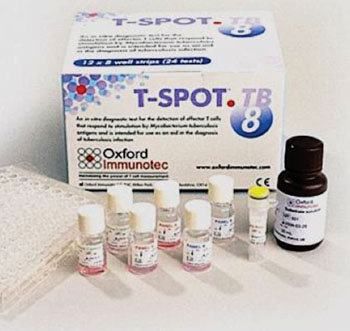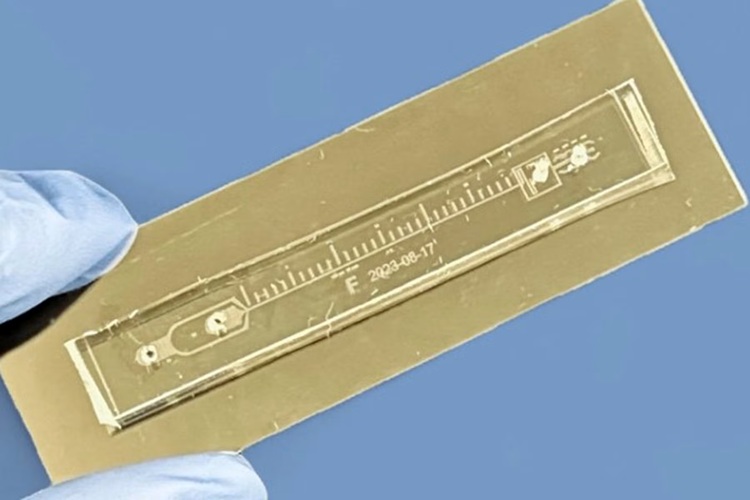Combined Tests Improve Tuberculous Meningitis Diagnosis
|
By LabMedica International staff writers Posted on 21 Feb 2016 |
At present, there is no established laboratory test to diagnose early tuberculous meningitis and cerebrospinal fluid (CSF) culture sensitivity is low in developing countries and it usually takes several weeks to obtain results with this method.
Tuberculous meningitis (TBM), the most severe form of tuberculosis (TB), accounts for 5% to 10% of extrapulmonary TB and 0.5% of systemic TB worldwide. Those who have contracted this disease have a mortality rate of 20% to 41% in developed countries and 44% to 69% in developing countries.
Scientists at Huashan Hospital Fudan University (Shanghai, China) studied a total of 30 patients who were suspected of having TBM, of whom six were clinically diagnosed as having TBM and 24 as probably harboring the disease. These patients included 24 men and six women, aged between 18 and 79 years, with a mean age of 45 years. The diagnostic criteria for TBM were positive acid-fast (AFS) results or positive CSF culture results for Mycobacterium tuberculosis.
After the first admission of each study participant from the TBM and control patient to the hospital, a 1-mL CSF specimen from each via lumbar puncture was collected. The team also collected cerebrospinal fluid from 10 patients in the TBM group on initial visit and at four weeks, to observe changes. A total of 30 individuals with TBM and 39 control individuals without TBM participated in this study. IFN-γ-secreting T cells were detected by ELISPOT, an enzyme-linked immunospot (T-SPOT.TB, Oxford Immunotec International, Abingdon, UK), and cerebrospinal fluid interferon-γ (cIFN-γ) was detected by enzyme-linked immunosorbent assay (ELISA).
The sensitivity and specificity of peripheral-blood T-SPOT.TB testing in the diagnosis of TBM were 70% and 87%, respectively. The area under the receiver operating characteristic (ROC) curve of cIFN-γ (greater than 81.36 pg/mL) for TBM diagnosis was 0.819, and the corresponding sensitivity and specificity were 83% and 85%, respectively. When T-SPOT.TB and cIFN-γ results were positive, the specificity and positive predictive value of TBM diagnosis reached 100%. The consistency is poor between peripheral-blood T-SPOT.TB and cIFN-methods probably due to the factors that could result in false-negative and false-positive results. However, this finding may partially confirm that the combination of these approaches can improve the efficiency of diagnosis of TBM.
The authors concluded that cIFN-γ testing is a rapid, economical, and highly sensitive approach to the diagnosis of TBM. Dynamic observation of cIFN-γ is important for monitoring patients with TBM, a condition that responds well to treatment. Peripheral blood T-SPOT.TB testing for TBM diagnosis is also important. The combination of peripheral blood T-SPOT.TB and cIFN-γ detection can improve overall sensitivity and specificity in the diagnosis of TBM. The study was published on January 4, 2016 in the journal Laboratory Medicine.
Related Links:
Huashan Hospital Fudan University
Oxford Immunotec International
Tuberculous meningitis (TBM), the most severe form of tuberculosis (TB), accounts for 5% to 10% of extrapulmonary TB and 0.5% of systemic TB worldwide. Those who have contracted this disease have a mortality rate of 20% to 41% in developed countries and 44% to 69% in developing countries.
Scientists at Huashan Hospital Fudan University (Shanghai, China) studied a total of 30 patients who were suspected of having TBM, of whom six were clinically diagnosed as having TBM and 24 as probably harboring the disease. These patients included 24 men and six women, aged between 18 and 79 years, with a mean age of 45 years. The diagnostic criteria for TBM were positive acid-fast (AFS) results or positive CSF culture results for Mycobacterium tuberculosis.
After the first admission of each study participant from the TBM and control patient to the hospital, a 1-mL CSF specimen from each via lumbar puncture was collected. The team also collected cerebrospinal fluid from 10 patients in the TBM group on initial visit and at four weeks, to observe changes. A total of 30 individuals with TBM and 39 control individuals without TBM participated in this study. IFN-γ-secreting T cells were detected by ELISPOT, an enzyme-linked immunospot (T-SPOT.TB, Oxford Immunotec International, Abingdon, UK), and cerebrospinal fluid interferon-γ (cIFN-γ) was detected by enzyme-linked immunosorbent assay (ELISA).
The sensitivity and specificity of peripheral-blood T-SPOT.TB testing in the diagnosis of TBM were 70% and 87%, respectively. The area under the receiver operating characteristic (ROC) curve of cIFN-γ (greater than 81.36 pg/mL) for TBM diagnosis was 0.819, and the corresponding sensitivity and specificity were 83% and 85%, respectively. When T-SPOT.TB and cIFN-γ results were positive, the specificity and positive predictive value of TBM diagnosis reached 100%. The consistency is poor between peripheral-blood T-SPOT.TB and cIFN-methods probably due to the factors that could result in false-negative and false-positive results. However, this finding may partially confirm that the combination of these approaches can improve the efficiency of diagnosis of TBM.
The authors concluded that cIFN-γ testing is a rapid, economical, and highly sensitive approach to the diagnosis of TBM. Dynamic observation of cIFN-γ is important for monitoring patients with TBM, a condition that responds well to treatment. Peripheral blood T-SPOT.TB testing for TBM diagnosis is also important. The combination of peripheral blood T-SPOT.TB and cIFN-γ detection can improve overall sensitivity and specificity in the diagnosis of TBM. The study was published on January 4, 2016 in the journal Laboratory Medicine.
Related Links:
Huashan Hospital Fudan University
Oxford Immunotec International
Read the full article by registering today, it's FREE! 

Register now for FREE to LabMedica.com and get access to news and events that shape the world of Clinical Laboratory Medicine. 
- Free digital version edition of LabMedica International sent by email on regular basis
- Free print version of LabMedica International magazine (available only outside USA and Canada).
- Free and unlimited access to back issues of LabMedica International in digital format
- Free LabMedica International Newsletter sent every week containing the latest news
- Free breaking news sent via email
- Free access to Events Calendar
- Free access to LinkXpress new product services
- REGISTRATION IS FREE AND EASY!
Sign in: Registered website members
Sign in: Registered magazine subscribers
Latest Microbiology News
- Rapid Assay Identifies Bloodstream Infection Pathogens Directly from Patient Samples
- Blood-Based Molecular Signatures to Enable Rapid EPTB Diagnosis
- 15-Minute Blood Test Diagnoses Life-Threatening Infections in Children
- High-Throughput Enteric Panels Detect Multiple GI Bacterial Infections from Single Stool Swab Sample
- Fast Noninvasive Bedside Test Uses Sugar Fingerprint to Detect Fungal Infections
- Rapid Sepsis Diagnostic Device to Enable Personalized Critical Care for ICU Patients
- Microfluidic Platform Assesses Neutrophil Function in Sepsis Patients
- New Diagnostic Method Confirms Sepsis Infections Earlier
- New Markers Could Predict Risk of Severe Chlamydia Infection
- Portable Spectroscopy Rapidly and Noninvasively Detects Bacterial Species in Vaginal Fluid
- CRISPR-Based Saliva Test Detects Tuberculosis Directly from Sputum
- Urine-Based Assay Diagnoses Common Lung Infection in Immunocompromised People
- Saliva Test Detects Implant-Related Microbial Risks
- New Platform Leverages AI and Quantum Computing to Predict Salmonella Antimicrobial Resistance
- Early Detection of Gut Microbiota Metabolite Linked to Atherosclerosis Could Revolutionize Diagnosis
- Viral Load Tests Can Help Predict Mpox Severity
Channels
Clinical Chemistry
view channel
Chemical Imaging Probe Could Track and Treat Prostate Cancer
Prostate cancer remains a leading cause of illness and death among men, with many patients eventually developing resistance to standard hormone-blocking therapies. These drugs often lose effectiveness... Read more
Mismatch Between Two Common Kidney Function Tests Indicates Serious Health Problems
Creatinine has long been the standard for measuring kidney filtration, while cystatin C — a protein produced by all human cells — has been recommended as a complementary marker because it is influenced... Read moreMolecular Diagnostics
view channel
New Genetic Test Enables Faster Diagnosis of Rare Diseases
Rare disease diagnosis often involves a long and uncertain search for the underlying genetic cause. Traditional testing requires multiple separate analyses, although many patients remain without answers.... Read more
Urine Test Detects Inherited Neuropathy Missed by Genetic Screening
Sorbitol dehydrogenase (SORD)-related neuropathy is one of the most common inherited nerve disorders, yet diagnosis often lags because current genetic screens frequently miss the causal gene.... Read moreHematology
view channel
Platelet Activity Blood Test in Middle Age Could Identify Early Alzheimer’s Risk
Early detection of Alzheimer’s disease remains one of the biggest unmet needs in neurology, particularly because the biological changes underlying the disorder begin decades before memory symptoms appear.... Read more
Microvesicles Measurement Could Detect Vascular Injury in Sickle Cell Disease Patients
Assessing disease severity in sickle cell disease (SCD) remains challenging, especially when trying to predict hemolysis, vascular injury, and risk of complications such as vaso-occlusive crises.... Read more
ADLM’s New Coagulation Testing Guidance to Improve Care for Patients on Blood Thinners
Direct oral anticoagulants (DOACs) are one of the most common types of blood thinners. Patients take them to prevent a host of complications that could arise from blood clotting, including stroke, deep... Read moreImmunology
view channel
Chip Captures Cancer Cells from Blood to Help Select Right Breast Cancer Treatment
Ductal carcinoma in situ (DCIS) accounts for about a quarter of all breast cancer cases and generally carries a good prognosis. This non-invasive form of the disease may or may not become life-threatening.... Read more
Blood-Based Liquid Biopsy Model Analyzes Immunotherapy Effectiveness
Immunotherapy has revolutionized cancer care by harnessing the immune system to fight tumors, yet predicting who will benefit remains a major challenge. Many patients undergo costly and taxing treatment... Read morePathology
view channel
Blood Test and Sputum Analysis Predict Acute COPD Exacerbation
Chronic obstructive pulmonary disease (COPD) remains a major contributor to global illness, largely driven by cigarette smoking and marked by irreversible lung damage. Acute exacerbations can accelerate... Read more
AI Tool to Transform Skin Cancer Detection with Near-Perfect Accuracy
Melanoma continues to be one of the most difficult skin cancers to diagnose because it often resembles harmless moles or benign lesions. Traditional AI tools depend heavily on dermoscopic images alone,... Read more
Unique Immune Signatures Distinguish Rare Autoimmune Condition from Multiple Sclerosis
Myelin oligodendrocyte glycoprotein antibody–associated disease (MOGAD) is a rare autoimmune disorder in which the immune system attacks the myelin sheath in the central nervous system. Although symptoms... Read moreTechnology
view channel
AI Saliva Sensor Enables Early Detection of Head and Neck Cancer
Early detection of head and neck cancer remains difficult because the disease produces few or no symptoms in its earliest stages, and lesions often lie deep within the head or neck, where biopsy or endoscopy... Read more
AI-Powered Biosensor Technology to Enable Breath Test for Lung Cancer Detection
Detecting lung cancer early remains one of the biggest challenges in oncology, largely because current tools are invasive, expensive, or unable to identify the disease in its earliest phases.... Read moreIndustry
view channel
Abbott Acquires Cancer-Screening Company Exact Sciences
Abbott (Abbott Park, IL, USA) has entered into a definitive agreement to acquire Exact Sciences (Madison, WI, USA), enabling it to enter and lead in fast-growing cancer diagnostics segments.... Read more








 assay.jpg)

















